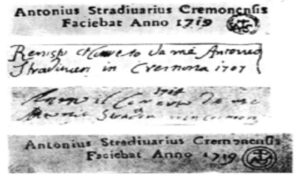Doctor Curmudgeon® What Makes Them Special?
By Diane Batshaw Eisman, M.D. FAAP Doctor Eisman is in Family Practice in Aventura, Florida with her partner, Dr. Eugene Eisman, an internist/cardiologist
Music is an important part of my life.
And so, when a friend invited me to his son’s music recital, I accepted. His son had studied violin for years and was excellent.
It was not long before I began to regret my decision. I moved restlessly, but quietly in my chair. Painfully, I held back my grimaces.
What was my problem?
I was listening to a youngster attack his violin! It was truly an awful mélange of various squeaks, without rhythm or love of the instrument.
The man in front of me whispered to his companion, “Not even a Stradivari would help!!!
A Stradivari! Thinking about Antonio Stradivari enabled me to ignore the music. I knew that he was one of the great Italian violin makers, a master craftsman.
He was born around 1644 in Cremona, Italy and began his illustrious career as a woodworker and carver.
But why are violins crafted by Stradivari considered to be among the finest? Why is their sound so unique? His violins have a bigger sound and project their music through large concert halls better than others. Those who have heard them say they have an unparalleled brilliance..
Of course, there are many theories.
At first, scientists thought that there was something in the varnish –perhaps a secret ingredient that gave the violins their tone. Wrong! On analysis, nothing unusual was found in his varnish. It wasn’t the varnish that created the clarity of sound of the Stradivari violin. There was no secret to the varnish used at the time.
IF not the varnish, maybe it was the wood itself?
About forty years ago, Dr. Joseph Nagyvary, now a professor emeritus of biochemistry at Texas A&M theorized that the beautiful sound was due to not only the superb craftsmanship but chemicals that treated the wood in order to protect it from worm infestations.
On the website, The Brighter Side of News, Professor Nagyvary states, “All of my research over many years has been based on the assumption that the wood of the great masters underwent an aggressive chemical treatment, and this had a direct role in creating the great sound of the Stradivari.”
At Texas A&M, Lime water, zinc, aluminum, calcium and copper were found all over the wood, inside and on the outside. Could these chemicals be the source of a Stradivari violin’s unique acoustic properties? in those days, there were no patents. And so, each violin maker had his own closely guarded recipe of chemicals to prevent the infestation of worms. Stradivari’s blend was unique to him.
Even today a Stradivari is valued for its exquisite craftsmanship, incredible acoustics and is considered to be one of the finest violins ever made. They are enormously expensive. In 2011 A Stradivari was sold to an anonymous buyer for $15.9 million dollars.
I began to listen again as the youngster continued to torture his violin. It was true. Not even a Stradivari could have helped him.
THE PHOTO IS OF A STRADIVARI VIO.LIN OF 1703 ON EXHIBIT, BEHIND GLASS, AT THE MUSIKINSTRUMENTENMUSEUM (BERLIN MUSICAL iNSTRUMENT MUSEUM) 2006.
THE OTHER PHOTO IS OF THE MAKER’S LABEL FROM STRADIVARI
Dr. Curmudgeon suggests “Bitter Medicine”, Dr. Eugene Eisman’s story of his experiences–from the humorous to the intense—as a young army doctor serving in the Vietnam War.
Bitter Medicine by Eugene H. Eisman, M.D. –on Amazon
Doctor Curmudgeon® is Diane Batshaw Eisman, M.D., a physician-satirist. This column originally appeared on SERMO, the leading global social network for doctors.
SERMO www.sermo.com
Click Here to Order Boxing Interviews Of A Lifetime By “Bad” Brad Berkwitt


